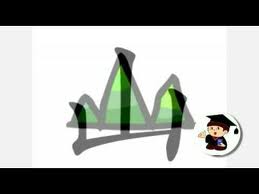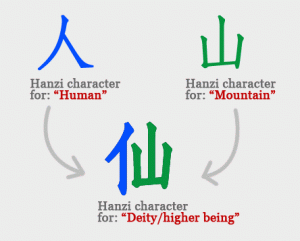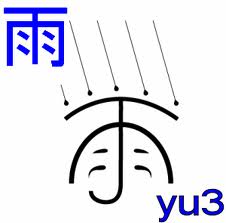What’s in a Chinese Character? (Vol. 3) Posted by sasha on Aug 23, 2012 in Culture, Vocabulary
It’s been a while since we’ve taken a closer look at the complexity of Chinese characters. To get you up to speed, here are the links to Volume 1 and Volume 2. So far, we’ve examined quite a few characters dealing with people. Today, we’ll focus more on nature, as we look at the history of a few important characters and how to use them.
No life is possible here on our great planet without water (水 – shuǐ). As with many Chinese characters, this one has evolved greatly over time. The earliest form of a Chinese symbol for water was simply a pictograph representing a river. A few dots were added on either side of the river to represent drops of water. When used as a radical, it becomes氵, which is meant to show three drops of water (三点水 – sān diǎn shuǐ). Many characters related to water use this radical, for example:
-
lake (湖 – hú)
-
sweat (汗 – hàn)
-
wave (浪 – làng)
The whole character itself can also be combined with others to form many different words, such as:
-
fruit (水果 – shuǐ guǒ)
-
ink (墨水 – mò shuǐ)
-
waterproof (不透水 – bù tòu shuǐ)
In China, water is one of the five elements (along with fire, wood, earth, and gold), and it symbolizes the Yin (阴 – yīn). Of course, you can’t have Yin without Yang (阳 – yáng). This brings us to…
The Chinese character for fire (火 – huǒ), which has also evolved through the centuries from a pictograph to the modern, simplified character that it is today. Of course, water can extinguish fire (水可以灭火 – shuǐ kě yǐ miè huǒ). This character also carries a few other meanings related to the heat of fire, and we can see this in a few characters where the radical for fire (灬) is used, such as:
-
hot (热 – rè)
-
boiled (煮 – zhǔ)
-
burnt (焦 – jiāo)
Many other words include the character for fire, including:
-
get angry (发火 – fā huǒ – lit. “send fire”)
-
fireworks (焰火 – yàn huǒ)
-
volcano (火山 – huǒ shān – lit. “fire mountain”)
Speaking of mountains, let’s have a look at…
The character for mountain (山 – shān). Of course, by this point in the lesson it should come as no surprise that this too evolved from a pictograph. When used as a radical, it retains its appearance. Here are a few examples of the radical for mountain in action:
-
lofty (嶒 – céng)
-
mountainous (崎 – qí)
-
high/steep (屹 – yì)
Of course, this character is also used to form a bunch of different words in Chinese. We’ve already seen how the character for mountain combined with fire makes the word “volcano.” So what happens when we combine it with the caracter for water??
-
landscape (山水 – shān shuǐ)
Many other words can be formed using this character, such as:
-
hilltop (山顶 – shān dǐng)
-
goat (山羊 – shān yáng – lit. “mountain sheep”)
This character is also used in one of my favorite Chinglish idioms – “people mountain people sea” (人山人海 – rén shān rén hǎi), which can be translated as “a vast crowd of people.” Also, when combined with the character for person, we get:
Before we go, let’s take a look at one more example – the character for rain (雨 – yǔ). In my humble opinion, this is one of the easiest characters to remember, as the modern day version still resembles the ancient pictograph – drops of rain falling from the clouds. Almost every Chinese character having to do with rain or clouds uses this as a radical.
Let’s check out a few examples:
-
thunder (雷 – léi)
-
sleet (霙 – yīng)
-
mist/haze (霭 – Ǎi)
When combined with other characters, more words related to rain can be formed:
-
umbrella (雨伞 – yǔ sǎn)
-
take precautions/plan ahead (未雨绸缪 – wèi yǔ chóu móu)
-
storm (暴风雨 – bào fēng yǔ)
As you can see, Chinese characters are both complex and incredibly interesting. Learning their history, how to use radicals, and how to combine basic characters with others to form words and phrases is the best way to go about building your Chinese vocabulary. Think of it as a Lego set – you start with the small pieces, and eventually you build something great.

Build vocabulary, practice pronunciation, and more with Transparent Language Online. Available anytime, anywhere, on any device.
About the Author: sasha
Sasha is an English teacher, writer, photographer, and videographer from the great state of Michigan. Upon graduating from Michigan State University, he moved to China and spent 5+ years living, working, studying, and traveling there. He also studied Indonesian Language & Culture in Bali for a year. He and his wife run the travel blog Grateful Gypsies, and they're currently trying the digital nomad lifestyle across Latin America.












Comments:
Gucci:
Quite good for starters i feel am good at chinese am really grateful.
Keep it up shíbó